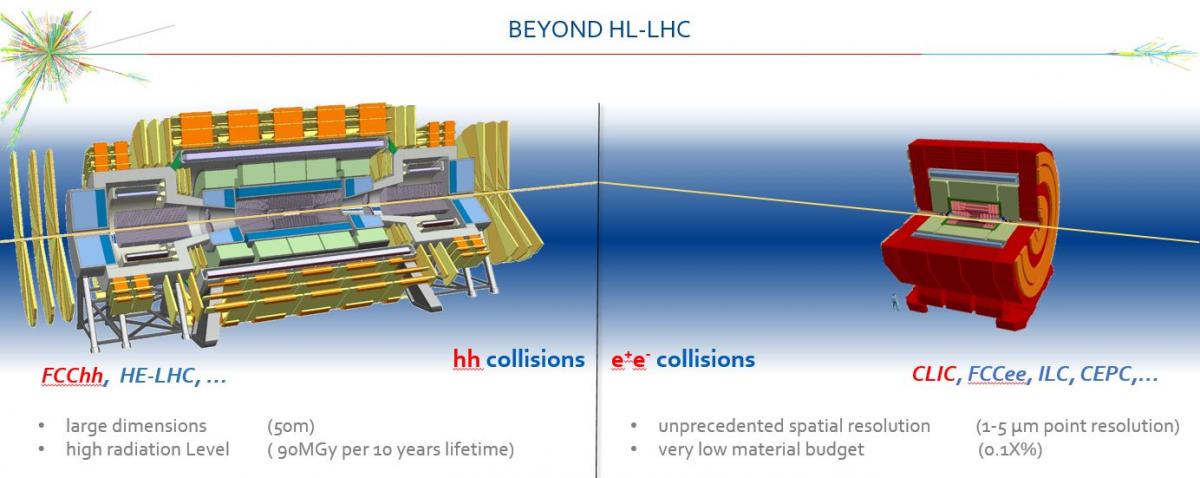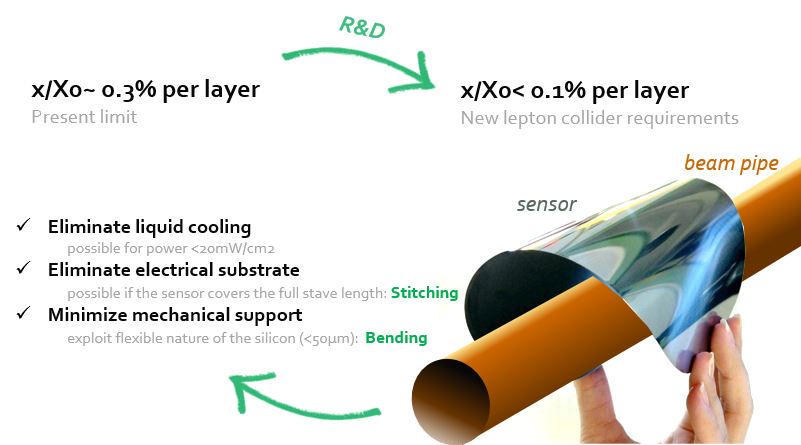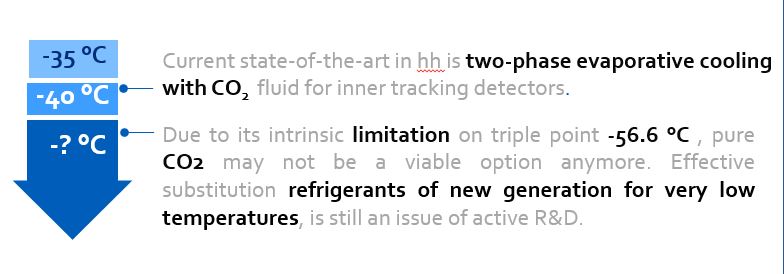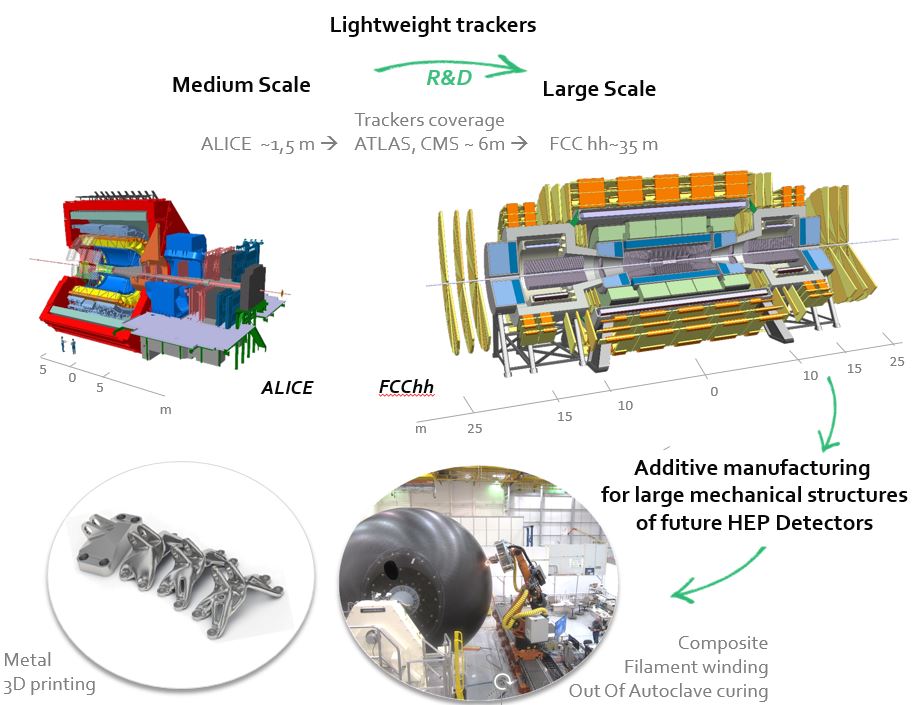Meeting the challenges of tracking detector mechanics
Designing detectors to meet the physics requirements of future high-energy experiments calls for a strong R&D program on new detector-systems. This includes sensors technologies, fast and efficient electronics, mechanics and cooling techniques that could cope with the environment offered in high-energy and high-intensity colliders planned for the post-LHC era. An important role in future R&D programs for the innermost vertex and tracking detectors is played by the mechanics that will have to cope with a wide range of competing requirements.
Figure 1: Future detector mechanics has to cope with large range of demanding requirements.
In an inspiring talk during a recent DT seminar, Corrado Gargiulo, discussed the challenges posed by future tracking detector mechanics at the High Luminosity upgrade of the LHC and future post-LHC colliders. In his presentation he discussed the planned upgrades for the silicon trackers of the four LHC experiments in the upcoming long shutdown periods. During LS2, LHCb plans to upgrade the VELO detector using Hybrid Pixel Sensor and ALICE will upgrade the Inner Tracking System using Monolithic Active Pixel Sensors. Further down the road, in LS3, CMS and ATLAS experiments plan major upgrades of their trackers including a combination of pixel and strips sensors for the inner and outer layers.
Figure 2: The upgrades of the tracking systems of the LHC Experiments at LS2 (ALICE and LHCb) and LS3 (ATLAS and CMS)
Corrado then projected the discussion into future, bridging and comparing design requirements from the upcoming LHC trackers upgrades to future detectors beyond the HL-LHC, and more specifically anticipating possible design directions for the mechanics. While the full exploitation of the potential of the HL-LHC is the clear top priority for the next 15 years, a number of studies for a major post-LHC project at CERN are being pursued: CLIC, FCC-hh, FCC-ee; complemented by advanced design studies of an International Linear Collider. Looking forward to the European strategy prioritizing the next big projects in the field, the wide range of future detectors can been grouped in hadron collider detectors and lepton collider detectors, in an attempt to address common requirements for mechanics and cooling. While the first will propose exceptionally large dimensions and extremely high radiation levels, the second will require unprecedented spatial resolution and thus extremely low material budget to avoid the emission of secondary particles as background, and high stability.
In the lepton collider experiments therefore the clear challenge for the mechanics will be to hold in position the next generation sensors with extraordinarily low material, while providing high stiffness and stability, with a target of <0.1% X0, for the Vertex detector innermost layer to compare with the limit of about 0.3% that will be reached in the LHC next upgrades. A future silicon pixel tracker, which excludes from the detector acceptance all services and mechanical support structures would represent an ideal design.
Figure 3: future vertex detectors aim to unprecedented minimum material budget which call for R&D on new sensor technologies and cooling solutions.
To eliminate the material in front of the sensor, new technologies, (like stitching) are pursued, capable to produce large area silicon sensors (from present few square cm to few hundred square cm). This would allow to cover most of the detection area with few sensors, confining the electrical interconnection to the sensors edge, outside the acceptance area. In addition the reduction of sensor thickness to few tens of microns will potentially allow for its direct bending to the final layer radius. Such layout would allow for removing power and data cable from the active area, minimizing mechanics and removing piping, where cooling solutions based on gas flow would be adopted.
At the other extreme, the harsh radiation environment in the future hadron collider experiments (ex. 90 MGy in 10 years lifetime for FCC-hh with 5x1017 1MeV neq/cm2), will impose severe constraints on the material used for the mechanics, while at the same time driving the cooling design.
Embedded liquid cooling systems in the mechanical substrates at the back of the sensors will allow at the same time to efficiently remove the dissipated heat and bring the sensors at lower and lower temperature, such to extend service life and limit leakage current in the new high radiation environment of hadron experiments.
Corrado also mentioned that for the cooling microchannel substrate, the microfabrication processes, either based on silicon microfabrication or carbon composite microvascular approaches, will need to be fully exploited and new additive manufacturing technologies (3D printing) and materials will be investigated. At the same time the needs to reach temperatures below -40°C will go beyond the limit of the present cooling solutions; new coolants will have to be studied and tested. As a long term prospective, the use of more environmental friendly cooling fluid will drive the research like Hydro Fluoro Olefeins (HFOs) and Fuoroketons (FK) that are now progressively substituting in the industry Hydrofluorocarbon (HFC) and Perfluorocarbons (PFC).
Figure 4: New detectors cooling requirements in high radiation environment will require the identification of new coolants and development of new system to reach lower temperatures.
Moreover, for covering large surfaces (e.g. the FCC-hh tracker length is 32 m to be compared to CMS/ATLAS length about 6 m) further research will push for cooling technologies that can be scaled to large areas without joints (heat pipes, passive thermal interface) which will provide reworkability and also increase the reliability of these systems. In general the minimization of the service connections, both hydraulic and electrical, and of the interfaces to the external world, should be pursued to minimize installation work. The risk of an increased integration should then be mitigated by automated assembly procedures and quality control.
Figure 5: Large scale dimensions of future trackers will require more automated and cheap processes.
Finally, Corrado pointed out that beyond the challenges, for the mechanics and cooling, to guarantee the next generation tracker performances, the new radiation levels in the hadron experiments will affect the future operational scenarios with an impact on the design of the detectors in terms of remote access and maintenance.
Figure 6: Designing Detectors that can be maintained by robots using appropriate and easily accessible interfaces such to decrease personnel exposures to hazards.
New detectors must be designed to be easily inspected and possibly maintained by robots so as to decrease personnel exposure to hazards. A completely new concept for detector connectivity, accesses and interfaces enabling use of automated systems/robots must be foreseen at the very first phase of detector design as it will influence the definition of the future experiment segmentation and layout.






